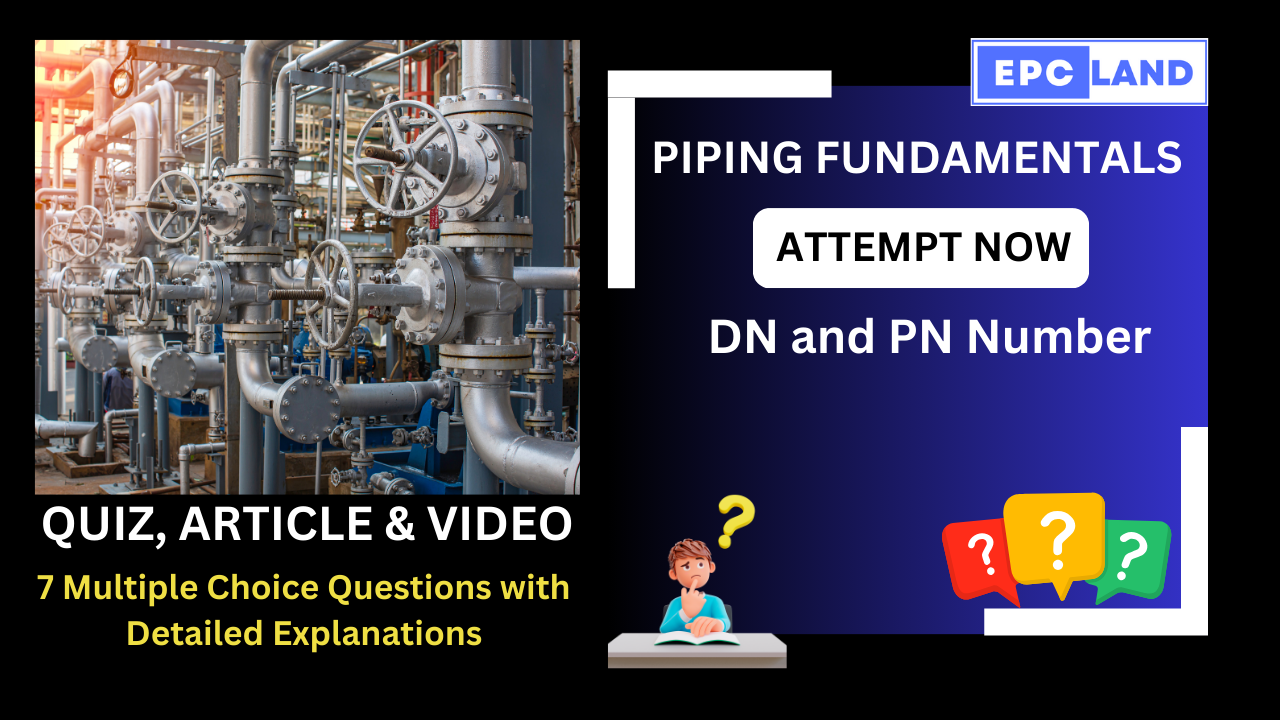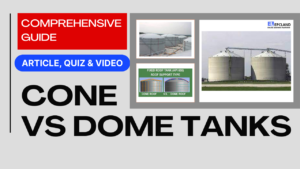1. What does DN and PN Number stand for?
Choose the correct definition of DN when we talk about DN and PN Number.
Explanation: DN stands for Diameter Nominal, representing the approximate pipe size in millimeters according to the ISO standard.
2. In which regions is NPS commonly used?
Identify the regions where Nominal Pipe Size (NPS) is primarily utilized.
Explanation: NPS, or Nominal Pipe Size, is primarily used in the United States and Canada.
3. What does PN stand for in PN Rating?
Choose the correct definition of PN in PN Rating.
Explanation: PN stands for Pressure Nominal in the context of PN Rating.
4. What does NPS 2 represent?
Identify the characteristic of a pipe with NPS 2.
Explanation: NPS 2 refers to a pipe with an approximate outside diameter of 2.375 inches.
5. What is the main difference between DN and NPS in terms of representation?
Identify the key difference in how DN and NPS represent pipe size.
Explanation: DN directly represents the approximate pipe size in millimeters, while NPS indirectly represents the size through a standard table.
6. What is the purpose of PN Rating in pipe classification?
Identify the role of PN Rating in classifying pipes.
Explanation: PN Rating is used to classify pipes based on their pressure-temperature rating.
7. Why are DN, NPS, and PN ratings crucial in piping systems?
Identify the importance of DN, NPS, and PN ratings in piping systems.
Explanation: DN, NPS, and PN ratings are crucial for design, size selection, compatibility, and safety in piping systems.
Short Article on What is DN and PN Number for Pipes?
DN (Diameter Nominal)
DN is a dimensionless number that represents the approximate pipe size in millimeters (mm) according to the ISO standard. It serves as a reference number to indicate the pipe size and is not a direct measurement of the pipe’s physical dimensions. The actual pipe dimensions may vary slightly depending on the pipe material and manufacturing process.
NPS (Nominal Pipe Size)
NPS, or Nominal Pipe Size, is another dimensionless pipe size designator used primarily in the United States and Canada. It indicates the pipe size by an NPS number followed by an inch (in.) designation. For instance, NPS 2 refers to a pipe with an approximate outside diameter of 2.375 inches.
Key Differences between DN and NPS
| Feature | DN | NPS |
|---|---|---|
| Unit of measurement | Millimeters (mm) | Inches (in.) |
| Pipe size representation | Directly represents the approximate pipe size in mm | Indicates the pipe size indirectly through a standard table |
PN Rating (Pressure Nominal)
PN, or Pressure Nominal, is a designation system used to classify pipes based on their pressure-temperature rating. It is commonly used for plastic pipes, such as HDPE, PVC, and PE pipes. The PN value, denoted by PN followed by a number, indicates the approximate pressure rating in bars that the pipe can withstand at a specified temperature. For instance, PN 16 pipe can withstand a pressure of 16 bar without failure at a specified temperature.
Pipe Class Rating vs. PN Numbers
Pipe Class Ratings are based on ASME (American Society of Mechanical Engineers) standards, while PN ratings follow ISO standards. The following table provides a cross-reference between PN ratings and ASME Class ratings:
| Pipe Class | PN Rating |
|---|---|
| 150 | 20 |
| 300 | 50 |
| 400 | 68 |
| 600 | 110 |
| 900 | 150 |
| 1500 | 260 |
| 2500 | 420 |
Applications of DN, NPS, and PN Ratings
DN, NPS, and PN ratings are crucial for various applications in piping systems. They are used to:
- Select the appropriate pipe size for a specific application: Based on the flow rate, pressure requirements, and available space, the appropriate DN or NPS size can be selected.
- Ensure compatibility between pipe components: DN, NPS, and PN ratings help ensure that different pipe components, such as fittings and valves, are compatible in terms of size and pressure rating.
- Maintain safety and prevent pipe failures: By adhering to the specified PN rating, pipes can safely operate at the intended pressure and temperature conditions, minimizing the risk of leaks, bursts, and other hazards.
In summary, DN, NPS, and PN ratings play a vital role in the design, selection, and safe operation of piping systems. Understanding these designations is essential for engineers, technicians, and anyone involved in the piping industry.
Table of Contents
Don’t miss the Course on Effective Isometrics Management: Check Now
Enrollment Link
Recommended courses (Published on EPCLand)
- Complete Course on Piping Engineering
- Basics of Piping Engineering
- Piping Layout Engineering
- Piping Material Engineering
- Piping Stress Analysis
- Material Requisitions
- Piping Material Specifications
- Valve Material Specifications
- Plant Design & Layouts-OISD 118
- Isometric Management
Library of Technical Articles
Don’t miss out the collection of 15+ articles on following topics:
- Basics of Oil and Gas Industry
- Valves
- Testing
- Tank
- Piping Bulk Items
- Pipe
- Metallurgy
- Piping Materials
- Layout
- Instrumentation
- Heat Exchanger
- Type of Contracts
- Codes and Standards
- ASTM Standards
- Articles on Piping Specialty Items
Video details of Complete Course on Piping Engineering
Why Enroll in the EPCLand
Proven Track Record– PTR
Activities & Achievements before launching EPCLand
- Published more than 50+ short courses
- 3000+ Enrolments
- More than 3,500,00 Minutes of watch hours in the last 2 years
- 4000+ Students in 100+ Countries
- Rating of 4+ out of 5
- 1000+ YouTube Videos
- 8K+ Subscribers
What Students will Learn
- Codes & Standards of the Energy Sector
- Piping Material Engineering
- Piping Layout Engineering
- Stress Analysis
Interesting facts
- All the published courses have been developed by Industry Experts with more than 2 decades of experience
- Content is based on Practical experience and real-time problems.
- Content is designed and organized in such a manner that it can be easily grabbed.
- Complete website, Blogs and Quiz sections are Planned, Designed and published by myself (About me: Atul Singla)
- Complete flexibility of Time & Location, Students can access the content from anywhere & anytime
- Moreover, once enrolled, the content can be access as many times as you want, which helps in understand the fundamentals in a better way.
Conclusion
In conclusion, our courses are meticulously crafted by industry experts with over two decades of hands-on experience. The content is rooted in practical knowledge, addressing real-time problems. The material is thoughtfully designed and organized for easy comprehension. Every aspect, from the website to blogs and quizzes, has been planned, designed, and executed by Atul Singla, ensuring a comprehensive and seamless learning experience. With the flexibility of accessing the content at any time and from any location, students have the freedom to learn on their terms. Furthermore, enrollment grants unlimited access, allowing learners to revisit the material as often as needed, fostering a deep understanding of the fundamentals.



